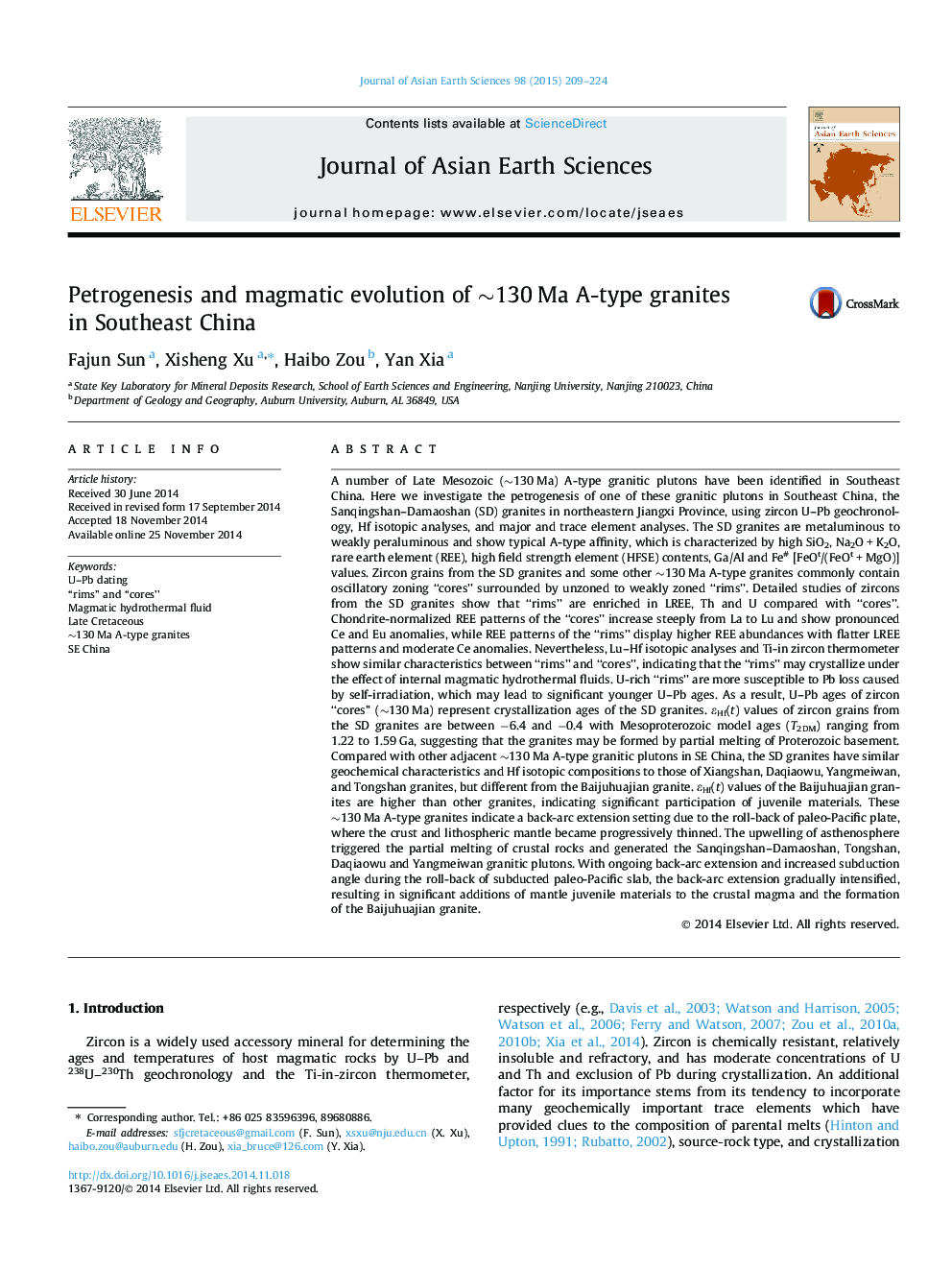| کد مقاله | کد نشریه | سال انتشار | مقاله انگلیسی | نسخه تمام متن |
|---|---|---|---|---|
| 6444377 | 1640371 | 2015 | 16 صفحه PDF | دانلود رایگان |
عنوان انگلیسی مقاله ISI
Petrogenesis and magmatic evolution of â¼130Â Ma A-type granites in Southeast China
دانلود مقاله + سفارش ترجمه
دانلود مقاله ISI انگلیسی
رایگان برای ایرانیان
موضوعات مرتبط
مهندسی و علوم پایه
علوم زمین و سیارات
زمین شناسی
پیش نمایش صفحه اول مقاله

چکیده انگلیسی
A number of Late Mesozoic (â¼130 Ma) A-type granitic plutons have been identified in Southeast China. Here we investigate the petrogenesis of one of these granitic plutons in Southeast China, the Sanqingshan-Damaoshan (SD) granites in northeastern Jiangxi Province, using zircon U-Pb geochronology, Hf isotopic analyses, and major and trace element analyses. The SD granites are metaluminous to weakly peraluminous and show typical A-type affinity, which is characterized by high SiO2, Na2O + K2O, rare earth element (REE), high field strength element (HFSE) contents, Ga/Al and Fe# [FeOt/(FeOt + MgO)] values. Zircon grains from the SD granites and some other â¼130 Ma A-type granites commonly contain oscillatory zoning “cores” surrounded by unzoned to weakly zoned “rims”. Detailed studies of zircons from the SD granites show that “rims” are enriched in LREE, Th and U compared with “cores”. Chondrite-normalized REE patterns of the “cores” increase steeply from La to Lu and show pronounced Ce and Eu anomalies, while REE patterns of the “rims” display higher REE abundances with flatter LREE patterns and moderate Ce anomalies. Nevertheless, Lu-Hf isotopic analyses and Ti-in zircon thermometer show similar characteristics between “rims” and “cores”, indicating that the “rims” may crystallize under the effect of internal magmatic hydrothermal fluids. U-rich “rims” are more susceptible to Pb loss caused by self-irradiation, which may lead to significant younger U-Pb ages. As a result, U-Pb ages of zircon “cores” (â¼130 Ma) represent crystallization ages of the SD granites. εHf(t) values of zircon grains from the SD granites are between â6.4 and â0.4 with Mesoproterozoic model ages (T2DM) ranging from 1.22 to 1.59 Ga, suggesting that the granites may be formed by partial melting of Proterozoic basement. Compared with other adjacent â¼130 Ma A-type granitic plutons in SE China, the SD granites have similar geochemical characteristics and Hf isotopic compositions to those of Xiangshan, Daqiaowu, Yangmeiwan, and Tongshan granites, but different from the Baijuhuajian granite. εHf(t) values of the Baijuhuajian granites are higher than other granites, indicating significant participation of juvenile materials. These â¼130 Ma A-type granites indicate a back-arc extension setting due to the roll-back of paleo-Pacific plate, where the crust and lithospheric mantle became progressively thinned. The upwelling of asthenosphere triggered the partial melting of crustal rocks and generated the Sanqingshan-Damaoshan, Tongshan, Daqiaowu and Yangmeiwan granitic plutons. With ongoing back-arc extension and increased subduction angle during the roll-back of subducted paleo-Pacific slab, the back-arc extension gradually intensified, resulting in significant additions of mantle juvenile materials to the crustal magma and the formation of the Baijuhuajian granite.
ناشر
Database: Elsevier - ScienceDirect (ساینس دایرکت)
Journal: Journal of Asian Earth Sciences - Volume 98, February 2015, Pages 209-224
Journal: Journal of Asian Earth Sciences - Volume 98, February 2015, Pages 209-224
نویسندگان
Fajun Sun, Xisheng Xu, Haibo Zou, Yan Xia,